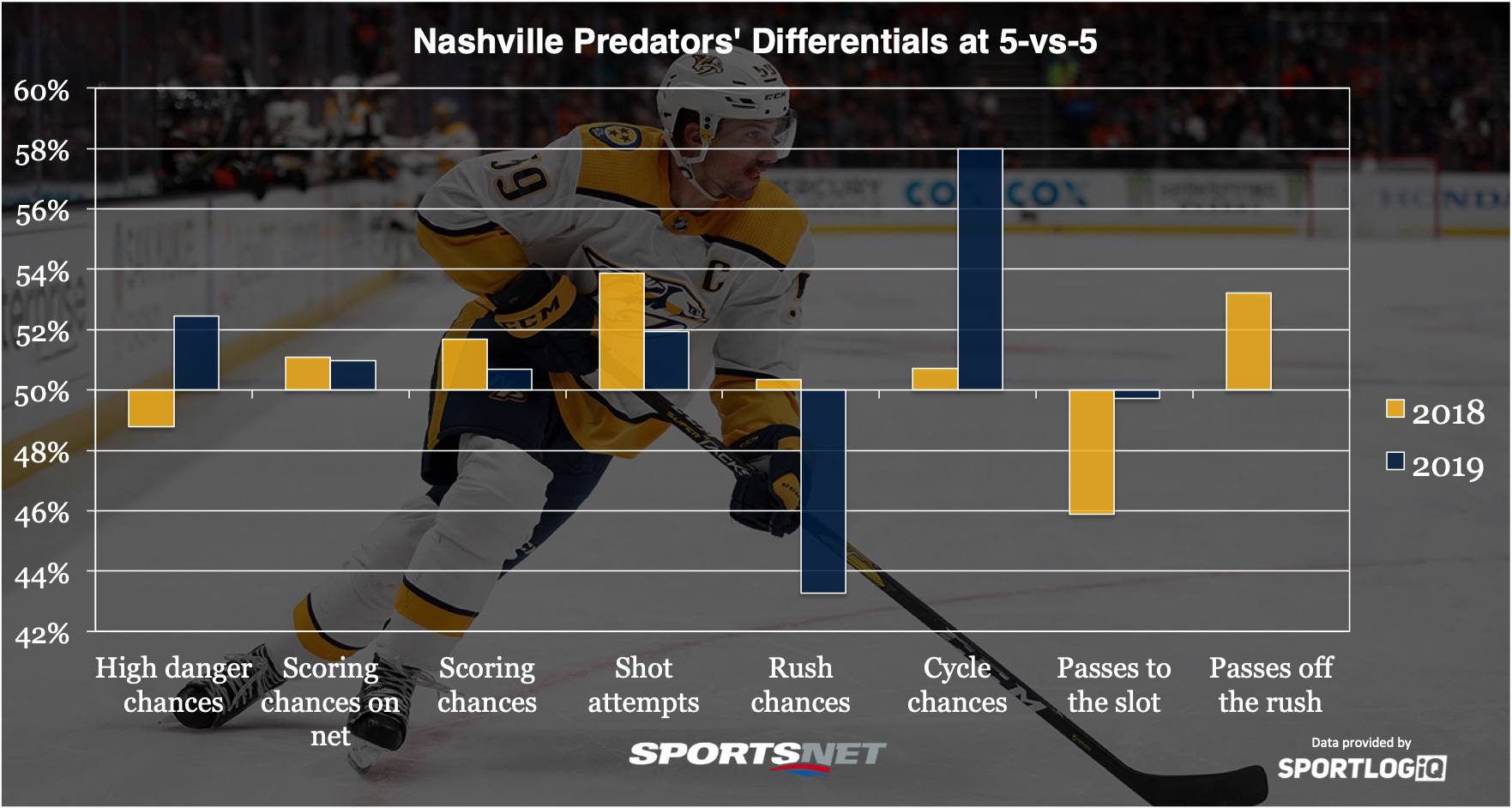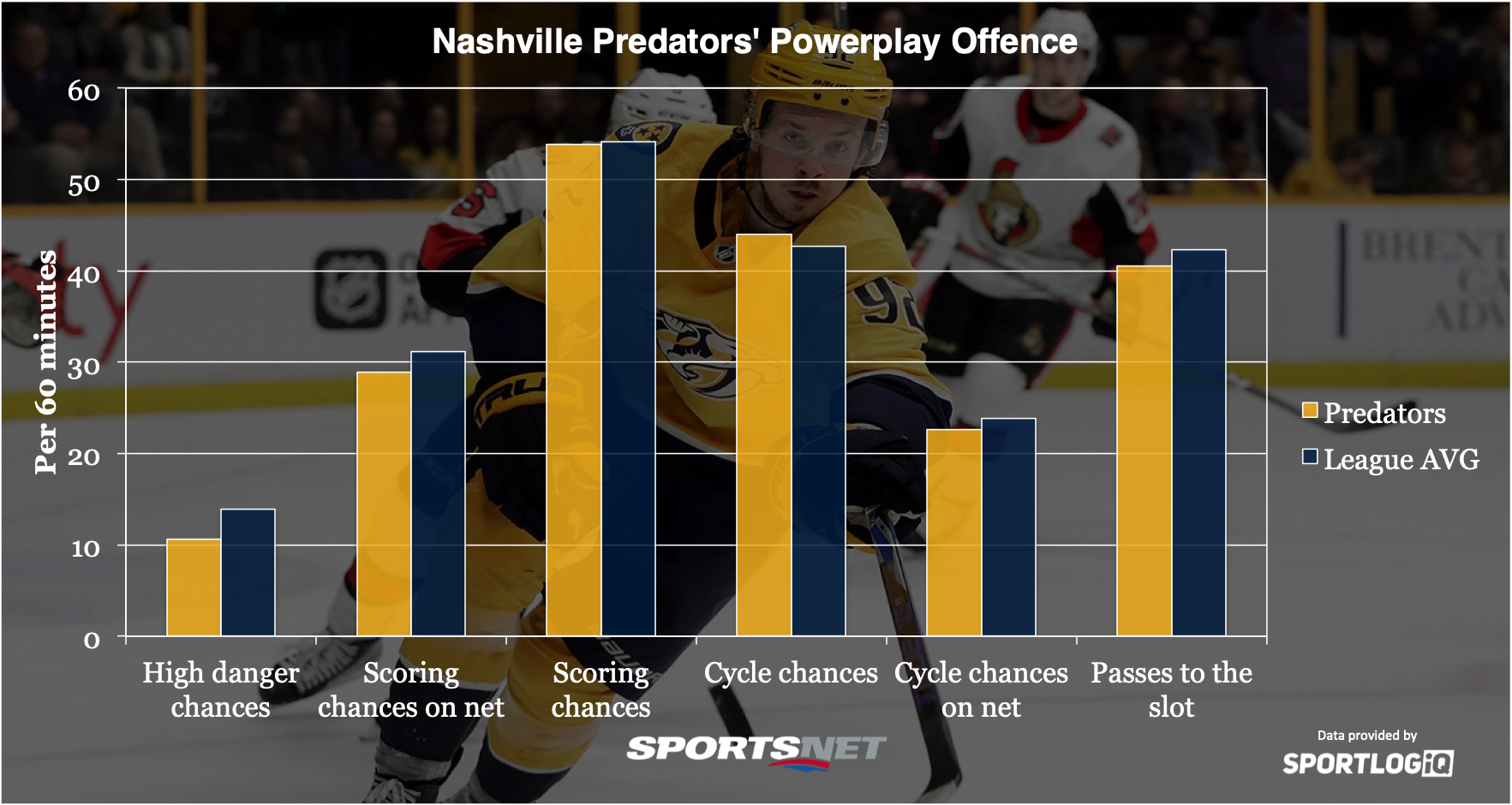After making the Stanley Cup Final two seasons ago, and winning the Presidents’ Trophy last season as the NHL’s top regular season team, the Nashville Predators carried the weight of great expectations into this season.
Through multiple injuries to key players, the Predators have treaded water this season while on pace for 100 points, 17 fewer than last season but still respectable. And yet the feeling when you follow Predators media and the fanbase on social media is one of mediocrity, with the Predators failing to meet the high standard expected of them.
For the first half of the season or so, injuries were a good excuse, one that I find wholly legitimate when you consider the players who missed time. Viktor Arvidsson played just 13 games before Dec. 27 and missed 24 games this season, P.K. Subban has missed 19 games, Filip Forsberg has missed 17, and Kyle Turris has missed 25 games. That’s a huge chunk of the Predators’ core missing time, a lot of it concurrently.
When looking at whether the Predators are contenders once again this season, we have to take into account those injuries and their impact on the underlying performance metrics of the team. Subban and Arvidsson returned to the lineup on Dec. 27, while Forsberg returned Jan. 7, so I think it’s fair to split the season at the new year, with the knowledge that Turris only recently returned to the lineup.
How do the Predators look at even strength with a mostly healthy lineup compared to the injury-riddled team we’ve seen most of the season?

In a general sense, the Predators remain a good team at controlling both shots and shot quality, which shouldn’t be surprising given they’re on pace for a 100-point season, but you can see from both the first section and the latter that not everything is rosy either, and some of the complaints about this team not quite having found “it” yet holds some water.
When dealing with injuries, the Predators were getting outplayed in high danger chances, but maintained decent differentials in scoring chances overall, and boasted a strong Corsi for percentage, which has been a mainstay for the last couple years, but along with high danger chances, the Predators were heavily losing the passes to the slot battle.
Since getting most of their injured players back, the Predators have flipped the script on high danger chances, now posting pretty strong differentials, and while they’re still allowing slightly more passes to the slot than they’re getting, that margin has been drastically slimmed.
That focus on high quality chances and passes seems to have come at a slight cost in shot attempts and scoring chances differentials, but the Predators are still at least on the right side of the ledger there.
What is extremely weird is that since the New Year, the Predators are the NHL’s most dominant cycle team at 5-on-5, while being the NHL’s worst team off the rush.
The changes the Predators have made appear to be focusing on more high-event, run and gun hockey, which has allowed them to generate more scoring chances than any other team except for the St. Louis Blues in 2019, but they’ve been surrendering a ton of chances as well.
Last season the Predators’ weakness heading into the playoffs was defending off the rush, which is why a Colorado Avalanche team that wasn’t particularly strong at even strength was able to push them so hard in the first round, and that problem seems to have reared its ugly head again this season, which has obscured the Predators’ in-zone dominance.
The Predators’ defence off the rush is very strange, because they’re only league average in the number of controlled entries they face, and above league average at stopping them before they start in the neutral zone, and league average at stopping the controlled entry just inside the blue line, but of the entries that do get through, almost all of them are dangerous.
41.1 per cent of attempted entries against the Predators end up with a conceded shot on net, and 31.5 per cent of them end in a conceded scoring chance, ranking the Predators 23rd and 25th in the league in those categories. Part of the reason for that is the Predators keep the biggest gap in the NHL in defending off the rush, with an average of 13.5 feet between the closest defender and the puck carrier, allowing them more time and space.
In 2019, the Predators have been even worse defending off the rush than their season average, allowing a scoring chance 35.3 per cent of the time. This is an issue that they’ll have to correct come playoff time if they want to go deep again.
Another area of concern for the Predators has been the powerplay, scoring on a league-worst clip of 12.9 per cent of their opportunities. The assumption looking at how Nashville’s powerplay has been run in recent years is that they’re banking too much on their elite group of defencemen to just pound the puck through traffic and in the net, but that doesn’t appear to be the issue.
The Predators get 54.6 per cent of their power-play shot attempts off from the slot, which ranks 15th in the NHL, which isn’t good, but also isn’t disastrous. So what’s going on there? Let’s break it down.

In terms of frequency, the Predators on the powerplay are below league average, but not by a lot. Their biggest issue has been the lack of high danger scoring chances, where they rank 26th in the league, but the addition of Brian Boyle and the return of Arvidsson address that issue fairly well. The rest of their shot quality metrics on the power play rank between league average and 20th, which doesn’t mean the man advantage is about to become a strength, but it doesn’t make it look like they’re the worst in the league either.
One issue I brought up with the Predators’ power play when looking at the Montreal Canadiens’ lack of success there, was that they just don’t attempt dekes to better their shooting position, no team attempts them less often. That has led to them being the team that has the highest percentage of their scoring chances blocked by opponents.
For a team with Filip Forsberg on it, that’s a bit strange, and it’s been Forsberg himself who has been most affected. Forsberg leads the Predators in power-play shot attempts with 90, but only 36 of those shots have been on net, 32 were blocked and the rest missed. That’s only 40 per cent of his attempted shots getting on net, the lowest percentage of any Predator except for Arvidsson, including defencemen.
From the slot, it’s even worse as Forsberg leads the team in scoring chances with 58, but only 21 of those have been on net, with 21 blocked and the rest missing. Once again, only Arvidsson has a lower success rate, with just six of his 19 scoring chances hitting the net on the power play.
It’s an easy out to blame coaching, which is probably average, and too much focus on the elite group of defencemen, but the biggest issue for the Preds on the power play is the two best shooters on the roster can’t get the puck on net. An average power play could go a long way to the Predators being real contenders again, but the issues off the rush and a lack of killer instinct while up a man make things questionable.
[relatedlinks]








